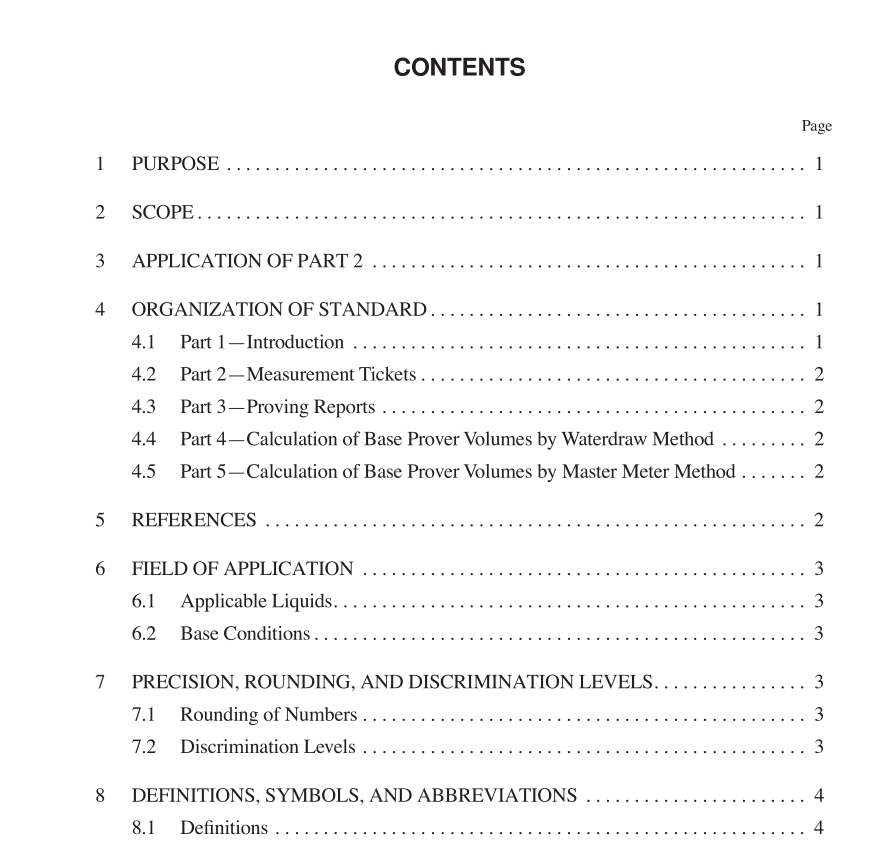API MPMS 12.2.2 pdf download

API MPMS 12.2.2 pdf download.Manual of Petroleum Measurement Standards Chapter 12—Calculation of Petroleum Quantities
1 Purpose
When most of the older standards were written, mechani- cal desk calculators were widely used for calculating mea- surement documentation, and tabulated values were used more widely than is the case today. Rules for rounding and the choice of how many Þgures to enter in each calculation step were often made on the spot. As a result, different opera- tors obtained different results from the same data. This Þve-part publication consolidates and standardizes calculations pertaining to metering petroleum liquids using turbine or displacement meters and clariÞes terms and expressions by eliminating local variations of such terms. The purpose of standardizing calculations is to produce the same unbiased answer from the given data. So that different opera- tors can obtain identical results from the same data, the rules for sequence, rounding, and discrimination of Þgures (or dec- imal places) have been deÞned.
2 Scope
This document provides standardized calculation methods for the quantiÞcation of liquids and the determination of base prover volumes under deÞned conditions, regardless of the point of origin or destination or the units of measure required by governmental customs or statute. The criteria contained in this document allow different entities using various computer languages on different computer hardware (or manual calcu- lations) to arrive at identical results using the same standard- ized input data. The publication rigorously speciÞes the equations for com- puting correction factors, rules for rounding, calculational sequence, and discrimination levels to be employed in the cal- culations. No deviations from these speciÞcations are permit- ted since the intent of this document is to serve as a rigorous standard.
3 Application of Part 2
The purpose of standardizing the terms and arithmetical procedures employed in calculating the amount of petro- leum liquid on a measurement ticket is to avoid disagree- ment between the parties involved. The purpose of Part 2, ÒMeasurement Tickets,Ó is to obtain the same unbiased answer from the same measurement data, regardless of who or what does the computing.Calculations of correction factors and volumes may be done using continuous online integration techniques if agreed between the parties. The results of these calculations may not agree with the methods contained in this standard due to the variability in obtaining ßowing parameters. However, the equations for computing correction factors and the rules for rounding, calculation sequence, and discrimination levels for any continuous online integration methods shall be identical to the speciÞcations contained in this standard. A measurement ticket is a written acknowledgment of a transfer of petroleum liquids and is the legal document of transfer. In addition, it serves as an agreement between the authorized representatives of the parties concerned as to the measured quantities and quality of the liquid. The measure- ment ticket shall contain all Þeld data required to calculate the metered quantities. Care must be taken to ensure that all copies of a measure- ment ticket are legible. Proper Þscal procedures forbid mak- ing corrections or erasures on a measurement ticket unless the interested parties agree to do so and initial the ticket to that effect. Should a mistake be made, the ticket should be marked ÒVOIDÓ and a new ticket prepared. The voided ticket should be attached to the new one to support the validity of the cor- rected ticket.
4 Organization of Standard
The standard is organized into Þve separate parts. Part 1 contains a general introduction for dynamic calculations. Part 2 focuses on the calculation of metered quantities for Þs- cal purposes or measurement tickets. Part 3 applies to meter proving calculations for Þeld operations or proving reports. Parts 4 and 5 apply to the determination of base prover vol- umes (BPVs).









